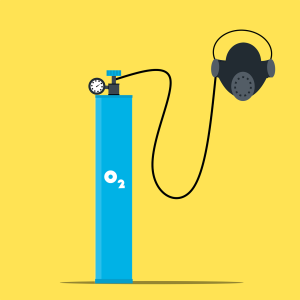An interesting and unique paper has been researched and published, ‘Explaining Adherence to Supplemental Oxygen Therapy:The Patient’s Perspective’ by Mark A Earnest. It looks at a group of COPD sufferers and investigates their use of oxygen therapy and the factors behind their varying adherence to their treatment regime.

For many people the level of adherence changes with time and reflects their struggle to manage their health, symptoms, physical ability and social issues. However adherence to oxygen therapy tended to increase with time as the realisation becomes apparent that a little compromise to lifestyle is required in order to reap the full benefits of oxygen therapy.
The barriers include the physical difficulty of using the oxygen, self-consciousness and a sense of social stigma, lack of perceived benefit, and fear of side effects from treatment.
The benefits far outweigh these barriers as supplemental oxygen therapy reduces mortality, improves sleep quality and general comfort, increases exercise tolerance, reduces pulmonary hypertension, normalizes heart rhythm patterns and improves cognitive brain function such as memory, intelligence, motor skills and perceptual motor ability.
The pattern of oxygen use adopted by any individual reflects their personal experiences and values and their efforts to optimally manage their lives. Four main areas affect adherence: functional management, health management, social management, and symptom management.
Functional Management
This is juggling the difficulty caused by weight and bulk, the perception that it hinders performing certain tasks with the benefit of improved fitness, strength, stamina and increased ability to perform these tasks.
Health Management
Individuals voiced concerns that they feared nasal dryness, nosebleeds and light-headedness. That they thought they may become addicted to it or that their lungs would become weakened.
These fears diminished as a result of personal experience. A realisation that the health benefits outweighed these fears and experience via an increase in use during episodes or on advice from a doctor.
Social Management
Social concerns relating to oxygen use, including embarrassment, self-consciousness, fear of burdening or inconveniencing others, concerns about appearing weak or sick, and a sense of shame, both about prior smoking and accepting dependence on a substance such as oxygen.
These elements tended to evolve over time. Some were able to overcome their fears or sense of self-consciousness by simply returning to a normal routine with family and friends. The desire to preserve independence and retain a high physical function and socialising helped them to overcome anysense of isolation and embarrassment. One woman described how,she felt once she followed her oxygen therapy fully:
‘It opened a whole new vista for me. All of a sudden I was getting more active. I was doing the grocery shopping, and the laundry, and driving, and just becoming self-sufficient, which was what I used to do. I started volunteering then (in the rehab program) as a way of thanking them, you know, for saving my life.’ (Female, age 69)
Symptom Management
The realisation that in most cases oxygen therapy helped to alleviate symptoms which resulted in a greater adherence to the treatment.
Management Balancing
Every participant in the study described some sense of compromise in the decisions they made regarding their use of oxygen. For most, the compromises were viewed as minimal or had been minimized by time and experience. In the four areas most patients realise that any uncertainties, fears or slight inconveniences in their lives were all far-outweighed by the benefits from oxygen therapy and adapted their lifestyles over time and through experiences and research, which generally resulted in an increased adherence to the treatment.
References: http://erj.ersjournals.com and http://www.ncbi.nlm.nih.gov




